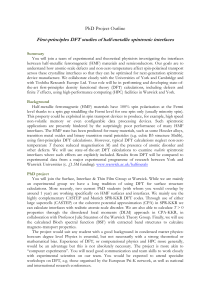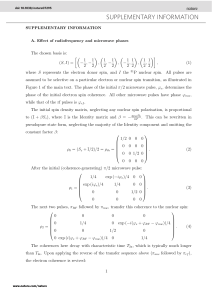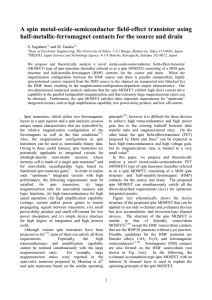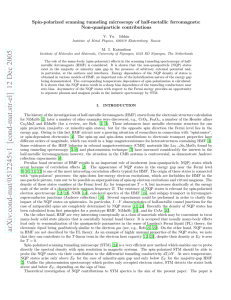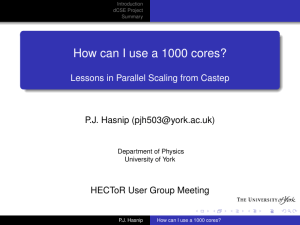Theory of spin-dependent electronic transport for the search for
advertisement
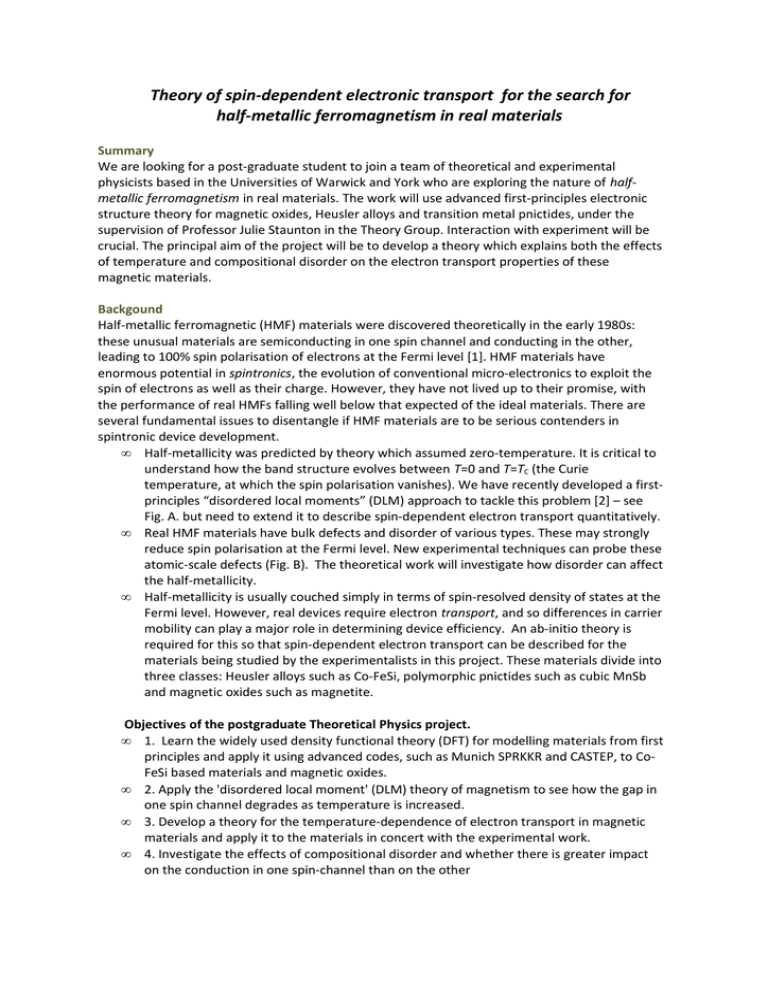
Theory of spin-dependent electronic transport for the search for half-metallic ferromagnetism in real materials Summary We are looking for a post-graduate student to join a team of theoretical and experimental physicists based in the Universities of Warwick and York who are exploring the nature of halfmetallic ferromagnetism in real materials. The work will use advanced first-principles electronic structure theory for magnetic oxides, Heusler alloys and transition metal pnictides, under the supervision of Professor Julie Staunton in the Theory Group. Interaction with experiment will be crucial. The principal aim of the project will be to develop a theory which explains both the effects of temperature and compositional disorder on the electron transport properties of these magnetic materials. Backgound Half-metallic ferromagnetic (HMF) materials were discovered theoretically in the early 1980s: these unusual materials are semiconducting in one spin channel and conducting in the other, leading to 100% spin polarisation of electrons at the Fermi level [1]. HMF materials have enormous potential in spintronics, the evolution of conventional micro-electronics to exploit the spin of electrons as well as their charge. However, they have not lived up to their promise, with the performance of real HMFs falling well below that expected of the ideal materials. There are several fundamental issues to disentangle if HMF materials are to be serious contenders in spintronic device development. • Half-metallicity was predicted by theory which assumed zero-temperature. It is critical to understand how the band structure evolves between T=0 and T=TC (the Curie temperature, at which the spin polarisation vanishes). We have recently developed a firstprinciples “disordered local moments” (DLM) approach to tackle this problem [2] – see Fig. A. but need to extend it to describe spin-dependent electron transport quantitatively. • Real HMF materials have bulk defects and disorder of various types. These may strongly reduce spin polarisation at the Fermi level. New experimental techniques can probe these atomic-scale defects (Fig. B). The theoretical work will investigate how disorder can affect the half-metallicity. • Half-metallicity is usually couched simply in terms of spin-resolved density of states at the Fermi level. However, real devices require electron transport, and so differences in carrier mobility can play a major role in determining device efficiency. An ab-initio theory is required for this so that spin-dependent electron transport can be described for the materials being studied by the experimentalists in this project. These materials divide into three classes: Heusler alloys such as Co-FeSi, polymorphic pnictides such as cubic MnSb and magnetic oxides such as magnetite. Objectives of the postgraduate Theoretical Physics project. • 1. Learn the widely used density functional theory (DFT) for modelling materials from first principles and apply it using advanced codes, such as Munich SPRKKR and CASTEP, to CoFeSi based materials and magnetic oxides. • 2. Apply the 'disordered local moment' (DLM) theory of magnetism to see how the gap in one spin channel degrades as temperature is increased. • 3. Develop a theory for the temperature-dependence of electron transport in magnetic materials and apply it to the materials in concert with the experimental work. • 4. Investigate the effects of compositional disorder and whether there is greater impact on the conduction in one spin-channel than on the other Figure A. Finite temperature spin polarisation in cubic MnSb and NiMnSb from DLM-DFT [2]. B. q-HAADF microscopy from magnetite, with Fe-site atomic structure overlain in yellow. The spot intensity can be quantitatively related to Fe site occupation, to estimate defect levels. C. HRTEM from Fe3O4/Al2O3 interface. Inset is the interface model obtained by multislice methods. A B C Research team and PhD project organisation You will join a 4-year £1.5M EPSRC-supported project Half-metallic ferromagnets: materials fundamentals for next-generation spintronics, which involves 7 academic staff in Warwick and York as well as research staff and industrial collaborators. The theoretical work is led by Professor Julie Staunton, who will also supervise this PhD project. Based in the Theory Group at Warwick, you will be able to benefit from graduate-level teaching through the Midlands Physics Alliance Graduate School (MPAGS) as well as specialised workshops such as those run by the Psi-K Network on advanced DFT applications. The project will access state-of-the-art experimental data (for example, from aberrationcorrected electron microscopy and synchrotron soft X-ray spin-polarised photoemission spectroscopy). References [1] [2] SPRKKR: CASTEP: DFT codes: Katsnelson et al., Rev. Mod. Phys. 80 (2008) 315. Aldous et al., Phys. Rev. B. 85 060403(R) (2012). http://olymp.cup.uni-muenchen.de http://www.castep.org/ http://www.psi-k.org/codes.shtml
